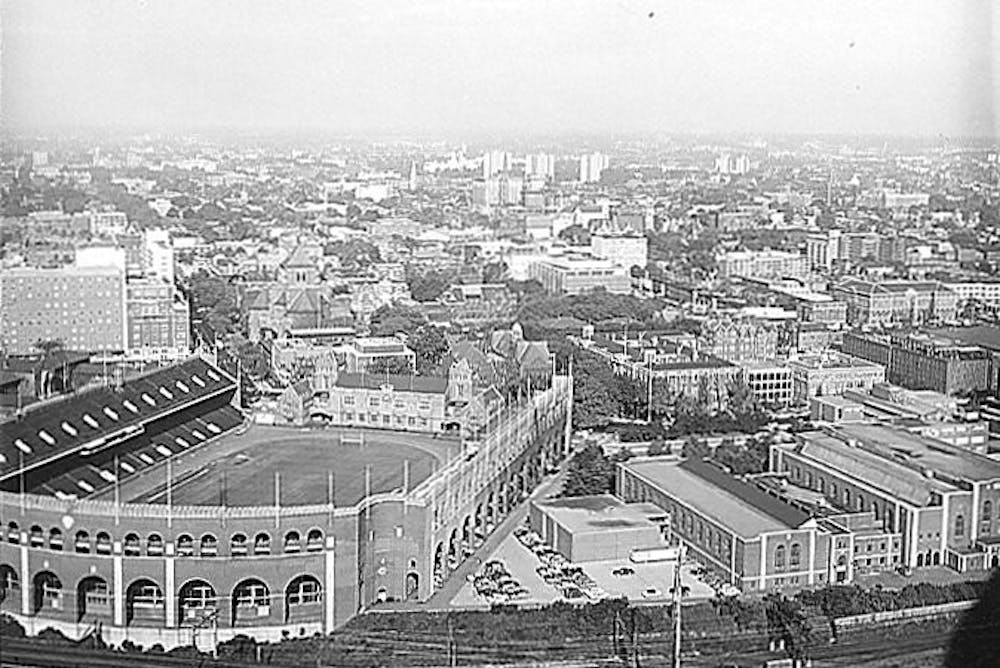It might come as a surprise to many that the Philadelphia Eagles played at Franklin Field for 13 seasons, but if it’s any consolation, many were surprised to see it happen at the time, too.
After spending 18 seasons at Connie Mack Stadium in North Philadelphia, which could only hold 39,000 people, the Eagles moved to Franklin Field, which could host well over 60,000. From 1958 to 1970, the Eagles played all of their home games at the legendary Penn stadium, amassing a total record of 41-45-2 while at the facility.
On Jan. 20, 1958, Eagles president Frank L. McNamee and Penn vice president John L. Moore, who were good friends after having worked together on the War Assets Administration during World War II, announced that the Eagles would be calling Franklin Field home for the foreseeable future.
The move was done out of financial necessity for both organizations, which lessened the surprise behind the move but didn’t diminish it completely.
“It was an awful shock when I first heard about it,” Crawford C. Madeira, a Penn graduate and major fundraiser for the University said at the time. “But after thinking it over, I don’t feel so bad about it. By letting the Eagles use it, it won’t become the white elephant it has been during the past two or three years. Since it’s a case of letting the stadium either crumble or letting the Eagles play there on Sundays, I’d say let the Eagles use it.”
The deal was agreed to initially as a three-year contract (though the agreement itself wasn’t put into writing) that involved Penn keeping the revenues from parking and concessions while the Eagles made donations toward the maintenance of the field, which amounted to between roughly $75,000 and $100,000 per year. This rent-free deal structure resulted due to Penn being a not-for-profit organization.
If the Eagles played at Franklin Field now, it would be impossible to imagine how jam-packed Penn’s campus might be, but at the time, the Eagles appeared to blend in quite nicely with the community. Former Dean G. Holmes Perkins emphasized the openness of the campus despite the insulation from the community.
“We’re hardly cloistered, as anyone who’s been around the campus when the Eagles are playing can see,” he said. “Even when the streets are closed, there will be enormously wide entrances to the public.”
RELATED:
Only in Philadelphia: A look back on the day Eagles fans booed Santa at Franklin Field
Stop and Smell the Rose Bowl: Penn's wild 1917 game against the Webfoots
Furthermore, being located on a university campus appeared to make the Eagles and their fanbase alike feel relatively comfortable.
“We became socially acceptable,” Tom Brookshier, a former Eagles cornerback, said in a 1997 interview with sportswriter Ray Didinger. “There was just something about walking across the grounds, past the statues and the library on a crisp fall day. People who could never go to Penn now could go to Penn on Sunday to see us. It was a great setting and we [the players] felt it, too.”

While Brookshier makes playing at Franklin Field seem quaint in a sense, the facility was still amenable to the trappings of the large scale of professional football. Outside of the Los Angeles Memorial Coliseum, where the Rams played their home games, Franklin Field was the largest professional football stadium at the time.
Despite the apparent immenseness of Franklin Field, it still provided a decent viewing experience for the Eagles’ fanbase.
“It was an incredible amphitheater,” Brookshier said in 1997. “There wasn’t a bad seat in the house. The stands went straight up so everyone was close to the field. We could hear the fans. If somebody in the upper deck called you a name, you could look up, point at the guy and say, ‘I’ll see you after the game.’”
Given the fact that it was roughly 60 years ago, this “I’ll see you after the game” mentality was more common while the Eagles played at Franklin Field than it is today.
“But it was in a different era,” former NFL player and executive Matt Millen, said in 2003. “Very passionate. Franklin Field was a crazy place. People took their football seriously. Hell, they’d run on the field to get at the players and coaches.”
This raucous fandom manifested itself into one of the great moments in Philadelphia sports lore when, in December of 1968, Eagles fans at Franklin Field booed and threw snowballs at a substitute Santa Claus. In part because of what occurred at Penn’s stadium, Philadelphia sports fans have forever been characterized by the national media as being rowdy, obnoxious, and having booed Santa Claus himself.
While most of the Eagles’ seasons at Penn ended in disappointment, they in fact won their third NFL title at Franklin Field in 1960, their last until 2017.
On December 26, 1960, Franklin Field was the home for the NFL Championship Game, as the Eagles squared up against Vince Lombardi’s Green Bay Packers. A crowd of 67,325 watched as the hometown team defeated Green Bay 17-13, resulting in Lombardi’s only career playoff loss.
According to one newspaper report, the roar that followed the final whistle could be heard as far west as 40th Street. Shortly thereafter, thousands of Eagles fans poured onto the field in celebration.
After almost leaving before the 1970 season, the Eagles finally transitioned into the newly-built Veterans Stadium, which was located in South Philadelphia and sat just over 65,000, in 1971.
While their time playing at Franklin Field is largely forgotten, the impact on the franchise as a result of the tenure has been instrumental in forming the identity the Eagles hold today.
In that same light, former Eagles owner and NFL Commissioner Bert Bell previously said that moving the team’s games to Franklin Field “saved pro football in Philadelphia.”









